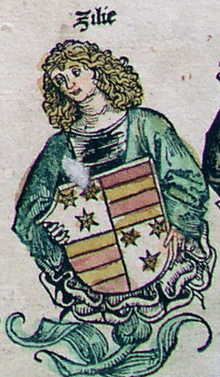Ulrich I, Count of Celje
Ulrich I (German: Ulrich von Cilli, Slovene: Ulrik Celjski; around 1331 – 1368), Count of Celje, was a Styrian nobleman and condottiere, who was head of the House of Celje between 1359 and 1368, together with his younger brother Hermann I. During his reign, the House of Celje became one of the most powerful noble houses in the territory of present-day Slovenia, and laid the basis for its expansion to neighboring Slavonia and Croatia in the next generation.[1] Ulrich's skills as a military commander are usually credited for the House of Celje's acceptance into the circles of the Central European high nobility in the second half of the 14th century.[2][3]
Ulrich I of Celje | |
|---|---|
 Ulrich's coat of arms | |
| Count of Celje | |
| Reign | 1359/60 – 1368 |
| Predecessor | Frederick I of Celje |
| Successor | Hermann I of Celje and William of Celje |
| Noble family | House of Celje |
| Spouse(s) | Adelaide of Ortenburg |
| Issue
William of Celje | |
| Father | Frederick I |
| Mother | Diemut of Walsee |
Life and achievements
Little is known of Ulrich's early life. He was the firstborn son of Frederick, first Count of Celje, and his wife Diemut Wallsee. Frederick had inherited the Celje Castle and the surrounding estates through his mother Catherine, daughter of the last Carinthian Count of Heunburg (Vovbre, in Slovene) and Agnes of Baden, the unsuccessful claimant to the Babenberg inheritance.
The Counts of Celje owed their success to the allegiance to the Habsburgs. Like his father before him, Ulrich served as the Landeshauptmann (governor) of the Habsburg Duchy of Carniola from 1362.
Ulrich served as a condottiere, a military contractor lending his services to more powerful lords. Through his services, he established particularly strong ties with the Luxembourg rulers of Bohemia and Germany, and the Hungarian branch of the Anjou dynasty. In 1354, he took part of the expedition of the Holy Emperor Charles IV to Italy. In 1354-55, he fought on the side of the Hungarian king Louis the Great against the Venetians in Dalmatia in 1354–55. Between 1359 and 1365, he took part of his expeditions to Serbia, Bulgaria and Southern Italy.[4]
The connection with the Hungarian and Polish king Louis proved fruitful. Ulrich's younger brother Hermann married Catherine of Bosnia, king Louis's sister in law, while Ulrich's son William married Anna of Poland, the daughter of Casimir the Great, the last Piast king of Poland. These marriages elevated the Counts of Celje into the circles of Central European royalty. At the same time, the settlement was convenient for Louis the Great who succeeded Casimir as King of Poland: Casimir's daughter, who might have otherwise claimed the throne for her children, was married off to Louis's loyal junior ally far away from Poland, thus neutralizing a potential challenge to his legitimacy in a problematic succession.[5]
Marriage and issue
Ulrich married Adelaide of Ortenburg, daughter of the powerful Carinthian count of Ortenburg. The marriage strengthened the alliance between the two houses. Only one son, William, survived into adulthood from this union. He married Anna of Poland, and had one daughter, Anna of Celje, who would become Polish queen consort by her marriage to Vladislav II.
Family tree
| Frederick I of Celje | Stephen II of Bosnia | ||||||||||||||||||||||||||||||||||||||||||||||||||
| Casimir the Great | Ulrich I | Hermann I of Celje | Catherine of Bosnia | Elizabeth of Bosnia | Louis the Great | ||||||||||||||||||||||||||||||||||||||||||||||
| Anna of Poland | William of Celje | Hermann II | |||||||||||||||||||||||||||||||||||||||||||||||||
| Anna of Celje | Vladislav II of Poland | ||||||||||||||||||||||||||||||||||||||||||||||||||
Ancestry
| Ancestors of Ulrich I, Count of Celje | |||||||||||||||||||||||||||||||||||||||||||||||||||||||||||||||||||||||||||||||||||||||||||||||||||||||||||||||||||||||||||||||||||||||||||||||||||||||||||||||||||||||||||||||||||||||||||||||||||||||||||||||||||||||||||||||||||||||||||||||||||||||||||||||||||||||||||||||||||||||||
|---|---|---|---|---|---|---|---|---|---|---|---|---|---|---|---|---|---|---|---|---|---|---|---|---|---|---|---|---|---|---|---|---|---|---|---|---|---|---|---|---|---|---|---|---|---|---|---|---|---|---|---|---|---|---|---|---|---|---|---|---|---|---|---|---|---|---|---|---|---|---|---|---|---|---|---|---|---|---|---|---|---|---|---|---|---|---|---|---|---|---|---|---|---|---|---|---|---|---|---|---|---|---|---|---|---|---|---|---|---|---|---|---|---|---|---|---|---|---|---|---|---|---|---|---|---|---|---|---|---|---|---|---|---|---|---|---|---|---|---|---|---|---|---|---|---|---|---|---|---|---|---|---|---|---|---|---|---|---|---|---|---|---|---|---|---|---|---|---|---|---|---|---|---|---|---|---|---|---|---|---|---|---|---|---|---|---|---|---|---|---|---|---|---|---|---|---|---|---|---|---|---|---|---|---|---|---|---|---|---|---|---|---|---|---|---|---|---|---|---|---|---|---|---|---|---|---|---|---|---|---|---|---|---|---|---|---|---|---|---|---|---|---|---|---|---|---|---|---|---|---|---|---|---|---|---|---|---|---|---|---|---|---|---|---|---|---|---|---|---|---|---|---|---|---|---|---|---|---|---|---|---|
| |||||||||||||||||||||||||||||||||||||||||||||||||||||||||||||||||||||||||||||||||||||||||||||||||||||||||||||||||||||||||||||||||||||||||||||||||||||||||||||||||||||||||||||||||||||||||||||||||||||||||||||||||||||||||||||||||||||||||||||||||||||||||||||||||||||||||||||||||||||||||
References
- Milko Kos. Zgodovina Slovencev od naselitve do reformacije. Ljubljana: Jugoslovanska knjigarna, 1933. P. 214.
- Čepič et al.: Zgodovina Slovencev. Ljubljana: Cankarjeva založba, 1979. P. 216.
- Milko Kos, Srednjeveška zgodovina Slovencev (Ljubljana: 1985), p. 261
- Čepič et al.: Zgodovina Slovencev. Ljubljana: Cankarjeva založba, 1979. Pp. 216-17.
- Peter Štih et al., eds, Spomini Helene Kottanner. Ljubljana, 1999